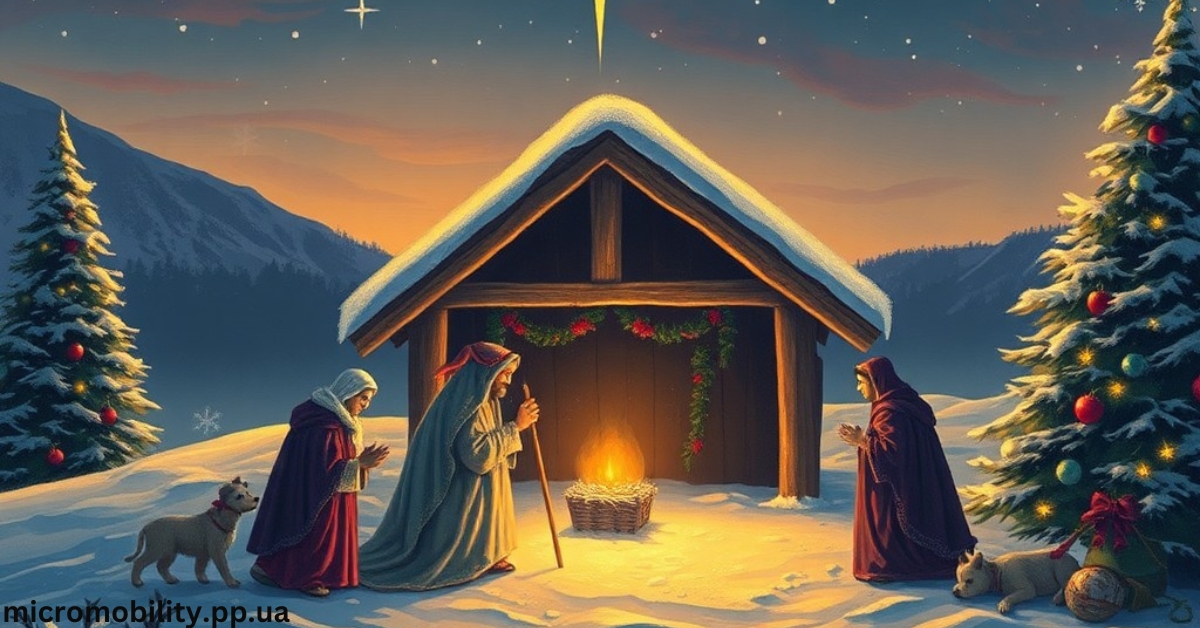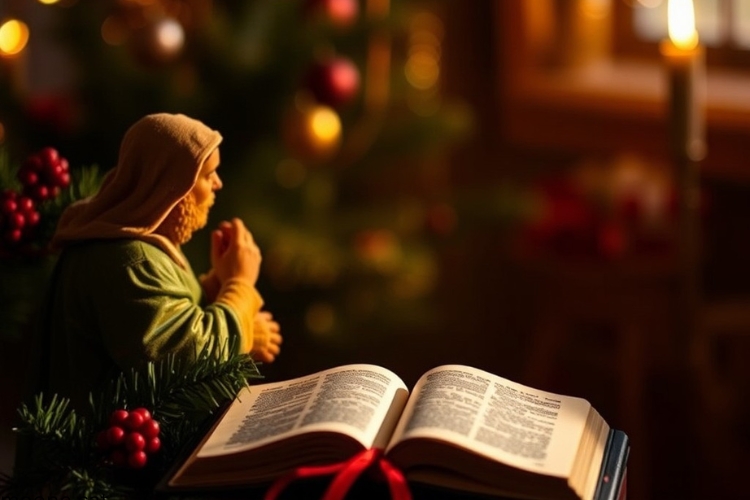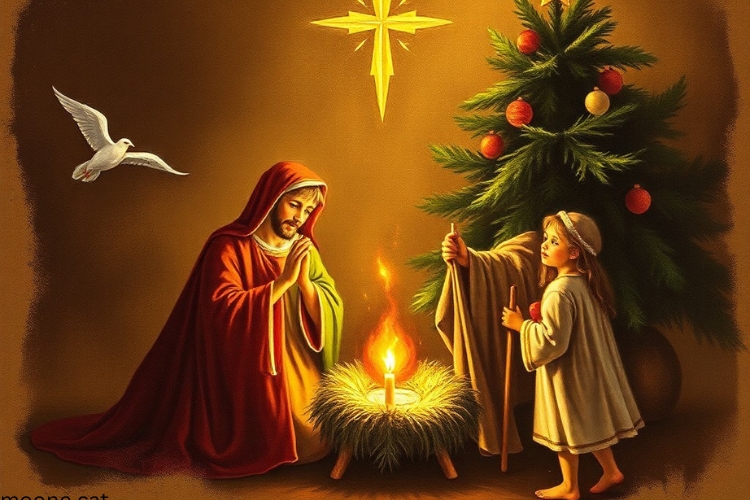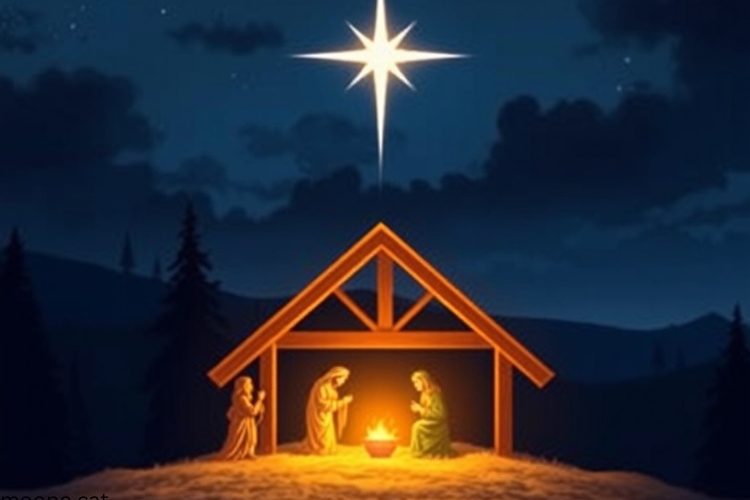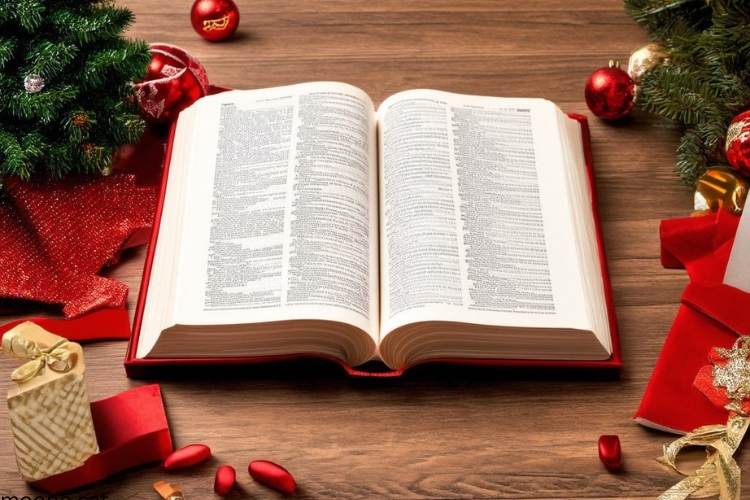The Christmas story, as told in the Gospels of Matthew and Luke, is a rich tapestry of events and symbols that has shaped Christian tradition for centuries.
In this blog post guide, we will explore about the biblical narratives, exploring the intricate details and profound theological implications of Jesus’ birth.
From the Nativity scenes to the prophetic fulfillments, from the humble shepherds to the majestic wise men, each element contributes to our understanding of Christmas and the incarnation of God in Jesus Christ.
Key Takeaways
- The accounts of Matthew and Luke provide distinct genealogies of Jesus, emphasizing his legal right to David’s throne and his fulfillment of prophecy.
- Christmas traditions such as the Christmas tree and gift-giving have evolved over time, incorporating both pagan and Christian symbolism.
- Key characters in the Christmas narrative, like Mary, Joseph, and the Magi, exemplify themes of obedience, faith, and a universal search for the divine.
- The doctrine of Immanuel, ‘God with us’, is central to the theological significance of Christmas, highlighting the mystery of the incarnation.
- The celebration of Christmas is not only a remembrance of Jesus’ birth but also a reflection on the deeper meanings of hope, joy, and salvation offered through Christ.
The Nativity Narratives: Matthew and Luke’s Accounts
Comparing the Genealogies of Jesus
The genealogies of Jesus presented in the Gospels of Matthew and Luke serve as more than a mere historical record; they are theological statements that highlight different aspects of Jesus’ identity and mission.
Matthew’s genealogy traces Jesus’ lineage through Joseph, emphasizing His legal right to the throne of David and His role as the Messiah for the Jewish people. In contrast, Luke’s account, which is believed to trace through Mary, presents Jesus as the Savior for all humanity, connecting Him to Adam and thus to every person.
- Matthew’s Genealogy:
- Starts with Abraham
- Emphasizes Jewish heritage
- Connects to King David
- Luke’s Genealogy:
- Starts with Adam
- Stresses universal significance
- Leads to Joseph, through Mary
The distinct genealogies converge in their declaration of Jesus as the rightful heir to the promises of God, each from their unique vantage point, yet together they weave a cohesive narrative of redemption.
The Virgin Birth: Prophecy and Fulfillment
The concept of the Virgin Birth is a cornerstone of Christian theology, signifying not only a miraculous event but also the fulfillment of ancient prophecies. Isaiah 7:14 is often cited as a foretelling of this event, where a virgin is prophesied to bear a son named Immanuel, meaning ‘God with us.
The fulfillment of this prophecy in the New Testament is detailed in the Gospels of Matthew and Luke, which describe Mary’s conception by the Holy Spirit, affirming the divine nature of Jesus from conception. This event bridges the Old and New Testaments, showcasing God’s unchanging plan for redemption.
The Virgin Birth underscores the intersection of the divine and the human, marking the inception of the Incarnation where the divine Word took on flesh.
While the Virgin Birth is a singular event in history, its implications resonate through Christian doctrine, emphasizing the purity and holiness necessary for the Messiah to redeem humanity.
Angels and Announcements: The Heavenly Messengers
The narrative of Christ’s birth is replete with divine interventions, most notably through the appearances of angels. These heavenly messengers played a pivotal role in the unfolding Christmas story, delivering critical announcements with implications that would echo throughout history.
- The angel Gabriel’s visitation to Mary, announcing her role as the mother of Jesus.
- An angelic host proclaiming the birth to the shepherds.
- Protective warnings given to Joseph in dreams.
The Christmas angels were not mere background characters; they were agents of God’s revelation, orchestrating the announcement of the Incarnation in a manner that was both miraculous and strategic.
The presence of angels in the Christmas narrative underscores the supernatural aspect of Jesus’ birth and the divine orchestration behind the events leading to the salvation of mankind.
The Significance of Bethlehem: City of David
Bethlehem’s significance in biblical narratives extends beyond its mention as the birthplace of Jesus. It is deeply rooted in the history of Israel and the lineage of David. Bethlehem was not only the setting for the Nativity but also a symbol of fulfillment of prophecy. The town’s connection to David is pivotal, as it was the place where he was anointed king and serves as a reminder of God’s promises to David’s lineage.
Bethlehem also features in the story of Ruth and Boaz, where it becomes the setting for redemption and covenant. The elders of Bethlehem, seated at the gates, witnessed legal transactions that shaped the future of David’s genealogy. This historical and spiritual heritage underscores the town’s importance in the biblical context.
- The town of David’s anointing and kingship
- The setting for Ruth and Boaz’s redemptive story
- A place of prophecy and promise
Bethlehem’s role in biblical history is not merely a backdrop for events but a testament to God’s unfolding plan across generations.
Symbols and Traditions: Unwrapping Christmas
The Christmas Tree: From Pagan to Christian Symbolism
The Christmas tree, a central symbol of the holiday season, has roots that intertwine with both pagan and Christian traditions. The transformation of the Christmas tree from a pagan emblem to a Christian symbol is a vivid example of the adaptation and reimagining of cultural practices over time.
The use of evergreen trees held symbolic meaning, representing the eternal life offered through faith in Jesus Christ. This association with immortality was seamlessly woven into Christian symbolism, as the evergreen nature of these trees mirrored the Christian promise of everlasting life.
The Christmas tree’s journey from pagan origins to Christian celebrations reflects the dynamic nature of cultural symbols and their ability to acquire new meanings.
While the tree’s pagan past is often acknowledged, its current significance is deeply rooted in the Christian narrative of redemption and hope. The following points highlight the tree’s evolution:
- The evergreen tree’s original representation of life during the winter solstice.
- The adoption of the tree by early Christians as a sign of Christ’s birth.
- The gradual integration of the tree into Christmas traditions, symbolizing the light and life brought by Jesus.
The Christmas tree today stands not only as a decoration but as a testament to the enduring nature of faith and the capacity for symbols to transcend their origins.
Gift-Giving: The Magi’s Influence on Modern Practices
The tradition of gift-giving during Christmas has profound roots, with the Magi or Wise Men presenting a timeless example. Their journey to present gifts to the newborn Jesus is a narrative that has shaped the way we celebrate Christmas today. The Magi’s gifts of gold, frankincense, and myrrh were not only valuable but also symbolic, representing Jesus’ kingship, divine nature, and eventual suffering and death.
The act of giving gifts at Christmas is a reflection of the generosity and reverence displayed by the Magi. It embodies the spirit of giving that is central to the holiday season.
While the Magi’s gifts were extraordinary, the practice of gift-giving has evolved. Today, it is a way to express love, generosity, and appreciation for family and friends. The following list highlights how the Magi’s actions continue to influence modern Christmas traditions:
- The exchange of gifts as a central Christmas activity
- The symbolic meaning behind each gift
- The joy of giving as a reflection of the Magi’s reverence
The Magi’s story invites us to consider the deeper meaning behind our own gift-giving practices. As we wrap presents and write cards, we participate in a tradition that is as ancient as it is meaningful, echoing the Magi’s homage to the Christ child.
Carols and Hymns: The Theology Behind Christmas Music
Christmas carols and hymns are not just melodious tunes that evoke the festive spirit; they are also rich in theological significance. Many carols encapsulate the core messages of Christianity, often recounting the nativity story, the incarnation, and the redemptive purpose of Christ’s birth. For instance, ‘Hark! The Herald Angels Sing’ exalts the incarnation of Jesus, emphasizing his divine nature and mission to bring salvation to humanity.
Beyond their narrative content, carols also serve as tools for worship and reflection. They invite listeners to ponder the mysteries of faith and to celebrate the profound truths of the gospel. A notable example is the carol ‘O Holy Night,’ which not only narrates the birth of Jesus but also touches on themes of hope and liberation.
The lyrics of Christmas music often go beyond the surface-level festivities to address deeper spiritual realities.
Here is a list of theological themes commonly found in Christmas carols:
- The sovereignty of God
- The fulfillment of prophecy
- The joy of salvation
- The call to worship
- The invitation to missions
These themes resonate with the message that some of the most popular Christmas carols are not just about the birth of Jesus but also about God’s power and dominion over the earth, as highlighted by the title ‘7 Christmas Carols That Are Actually About Missions – ABWE‘.
The Advent Wreath: Anticipation and Preparation
The Advent wreath is a cherished tradition in many Christian homes and churches, marking the passage of the four weeks leading up to Christmas. Each candle on the wreath represents an aspect of the spiritual preparation for the coming of Christ. The lighting of each candle symbolizes the growing anticipation of the birth of Jesus, and the progression from darkness to light.
- The first candle, often called the Prophet’s Candle, symbolizes hope and the prophecies about the coming Messiah.
- The second candle, the Bethlehem Candle, represents faith and the journey to Bethlehem.
- The third candle, known as the Shepherd’s Candle, is for joy and the announcement of Jesus’ birth to the shepherds.
- The fourth candle, the Angel’s Candle, stands for peace and the message of the angels.
The Advent wreath encapsulates the essence of Christian preparation, where each week serves as a reminder of the virtues central to the season: hope, faith, joy, and peace.
As the candles are lit, one by one, the increasing light is a powerful metaphor for the approach of the promised Messiah, echoing the words of Scripture that the world awaits in eager expectation for the revelation of the children of God.
The Characters of Christmas: Beyond the Manger Scene
Mary and Joseph: Obedience and Faith in the Face of Scandal
In the biblical narrative, Mary and Joseph stand as exemplars of faith and obedience amidst societal scandal. Their unwavering commitment to God’s plan, despite the potential for misunderstanding and reproach, underscores a profound trust in divine providence.
- Mary’s acceptance of the angel’s message without hesitation
- Joseph’s righteous decision to stand by Mary, guided by an angelic dream
Their journey was not just a physical one from Nazareth to Bethlehem, but also a spiritual odyssey that challenged and affirmed their faith.
The couple’s response to the extraordinary circumstances surrounding Jesus’ birth highlights the humility and courage required to partake in the unfolding of salvation history. Their legacy is a testament to the power of steadfast belief in the face of adversity.
The Shepherds: Humble Witnesses to Glory
In the biblical account of Christ’s birth, the shepherds play a pivotal role as humble witnesses to the divine glory that shone on the night of Jesus’ arrival. Their estate was one of subservience and humility. They were not the societal elite, nor the religiously esteemed, but rather simple laborers of the fields, embodying the very nature of the incarnation they were about to witness.
The shepherds’ experience encapsulates a profound theological truth: that God’s message of salvation first came to the lowly. This is a recurring theme throughout the scriptures, where God often chooses the least expected individuals to carry out His purposes.
The shepherds’ encounter with the angels reveals a God who bypasses the grandeur of temples and palaces to announce the birth of the Savior to those tending flocks under the starry sky.
Their response to the angelic announcement was immediate and obedient; they went to Bethlehem and found Mary, Joseph, and the baby Jesus, just as they had been told. Their subsequent actions serve as a model for believers:
- They shared the news of what they had seen and heard.
- They returned to their flocks, glorifying and praising God.
- Their lives were transformed by the encounter, as should be the lives of all who hear the good news.
The Wise Men: Gentile Seekers of the King
The journey of the Magi from the East, as depicted in Matthew Chapter 2, is a profound narrative that extends beyond the borders of Israel, symbolizing the revelation of Jesus to the Gentiles.
These wise men, guided by a celestial phenomenon, embarked on a quest that would lead them to pay homage to the newborn king, a journey that reflects the universal scope of Jesus’ mission.
The Wise Men’s pursuit is emblematic of the human search for truth and meaning. Their story invites us to consider the ways in which outsiders to our faith traditions can offer fresh insights into the divine.
While often romanticized in Christmas lore, the Wise Men’s visitation was a significant theological event, marking the inclusion of the Gentiles in the salvific plan of God. This inclusion was foretold by the prophets and is celebrated in the Christian tradition as a pivotal moment in the unfolding of God’s promise to bless all nations.
- The Magi’s recognition of Jesus as the Messiah
- Their gifts of gold, frankincense, and myrrh
- The dream that warned them to avoid Herod
- Their return home by another route
The Wise Men’s narrative challenges us to embrace the mystery and the majesty of Christmas, and to recognize the ways in which the birth of Jesus resonates with people of all backgrounds.
Herod the Great: Fear and Tyranny in Response to the Newborn King
The narrative of Christmas is not without its dark characters, and Herod the Great stands out as a stark contrast to the joy and hope the season represents. Known for his ruthless reign, Herod’s response to the birth of Jesus is marked by fear and a desperate attempt to cling to power. Since most scholars agree that Jesus was born around 6 BCE, Herod’s role in the Christmas story is pivotal.
Herod’s paranoia led to the infamous decree that resulted in the Massacre of the Innocents, a tragic event that underscores the threat Jesus’ birth posed to the established order.
The following points highlight Herod’s impact on the Christmas narrative:
- His inquiry to the Magi about the newborn “King of the Jews” reveals his deep insecurity.
- The slaughter of male infants in Bethlehem shows his willingness to commit atrocities to eliminate threats.
- Herod’s actions fulfill Old Testament prophecies, further intertwining his story with the biblical narrative.
Theological Implications of the Incarnation
God With Us: The Doctrine of Immanuel
The doctrine of Immanuel, meaning ‘God with us,’ is a cornerstone of Christian theology, encapsulating the profound mystery of the divine presence in the human story. The birth of Jesus Christ is celebrated as the moment when God entered the world in human form, fulfilling the prophecies and initiating a new era of hope and salvation.
The essence of the Immanuel principle is not just the historical event of Jesus’s birth, but the ongoing reality of God’s presence with His people. It is a promise that resonates with the faithful, offering comfort and guidance.
Understanding the doctrine of Immanuel involves recognizing the multifaceted ways in which God interacts with humanity:
- Through the historical person of Jesus Christ
- By the indwelling of the Holy Spirit in believers
- In the communal worship and fellowship of the church
- Through the personal relationship each believer can have with God
This doctrine is not only about the birth of Jesus but also about the continuous spiritual journey of believers drawing on His presence. As the angel declared to Joseph in a dream, ‘do not fear to take Mary as your wife,’ so too are believers encouraged to embrace the presence of God without fear, trusting in the transformative power of His love.
The Humility of Christ: From Majesty to Manger
The incarnation of Christ is a profound testament to the humility of God. From the splendor of heaven to the simplicity of a manger, Jesus’s birth marks a pivotal moment in divine condescension. This act of humility is not just a moral example; it is the foundation of Christian faith.
Humility is often overlooked in a world that prizes power and success. Yet, in the Christmas narrative, we see the King of Kings born in the most humble of circumstances, signaling that God’s kingdom values are radically different from the world’s.
- The pre-existence of Christ in glory
- The choice to be born in lowliness
- The significance of this act for humanity
The birth of Jesus in a manger is a powerful symbol of God’s willingness to meet us at our level, to become approachable and relatable to humanity.
Salvation’s Dawn: The Birth of the Savior
The birth of Jesus Christ marks the beginning of a new era in human history, an era where salvation became accessible to all. The Deep Significance of the Birth of Jesus Christ is not merely in the miraculous nature of His arrival but in the purpose He came to fulfill. He spoke words of righteousness and truth to bring people out of darkness and into light. Then in His body of flesh and blood, Jesus suffered death on the cross, paving the way for humanity’s redemption.
The nativity story is more than a tale of a baby in a manger; it is the prelude to the ultimate sacrifice for sin—the crucifixion and resurrection.
The following points outline the transformative impact of Jesus’s birth:
- It signified the fulfillment of numerous Old Testament prophecies.
- It heralded the arrival of God’s promised Messiah.
- It introduced the concept of God’s grace to a world entrenched in legalism.
- It established the foundation for the Christian faith and the Church.
The Mystery of the God-Man: Fully Divine, Fully Human
The doctrine of the Incarnation presents a profound mystery that has captivated theologians and believers alike. The union of divine and human natures in the person of Jesus Christ is a cornerstone of Christian faith. This mystery is not merely a theological puzzle to be solved but a truth to be embraced.
The Incarnation signifies that while Jesus walked the earth, he was not just an enlightened teacher or a prophetic figure; he was the fullness of God in human form. The implications of this are vast, affecting our understanding of salvation, redemption, and the very nature of God’s interaction with the world.
While the Bible does not provide a systematic exposition of this mystery, it offers glimpses into the complexity and beauty of the Incarnation. The Apostle Paul, in particular, reflects on this in his epistles, revealing that the Incarnation was not only foretold but also central to the message of the Gospel.
Conclusion
As we wrap up our exploration of the biblical perspectives on Christmas, we are reminded of the profound depth and richness found in the accounts of Matthew and Luke. These narratives, while distinct, harmoniously intertwine to present a story that has captivated hearts for centuries.
The mystery of the manger, the journey of the Magi, and the humble beginnings of Jesus in Bethlehem invite us to reflect on the divine orchestration of events that heralded the birth of the Savior.
Christmas, as depicted in the Bible, is not just a tale of historical significance but a living invitation to witness the wonder of God’s love manifested in the gift of His Son. As we celebrate this season, let us hold close the true essence of Christmas—the joyous news of Jesus Christ, who came to bring hope and salvation to all.
Frequently Asked Questions
What do the genealogies of Jesus in Matthew and Luke signify?
The genealogies of Jesus in Matthew and Luke establish His legal right to the throne of David and demonstrate His fulfillment of Old Testament prophecy as the Messiah. Matthew’s genealogy traces Jesus’ lineage through Joseph, while Luke’s genealogy goes through Mary, highlighting Jesus’ connection to humanity and divinity.
How is the virgin birth a fulfillment of prophecy?
The virgin birth fulfills the prophecy found in Isaiah 7:14, which states that a virgin shall conceive and bear a son, and shall call his name Immanuel. This highlights the miraculous nature of Jesus’ birth and His identity as God with us.
Why is Bethlehem significant in the Christmas story?
Bethlehem is significant as it is the city of David, and the prophet Micah foretold that the ruler of Israel would come from Bethlehem (Micah 5:2). Jesus’ birth in Bethlehem fulfills this prophecy and connects Him to the Davidic line.
What is the symbolism behind the Christmas tree?
The Christmas tree, originally a pagan symbol, was adopted by Christians and is now seen as a representation of everlasting life with God. The evergreen tree symbolizes the eternal life Jesus brings, and its triangular shape points to the Trinity.
How did the Magi influence modern gift-giving traditions?
The Magi, or Wise Men, brought gifts of gold, frankincense, and myrrh to the infant Jesus. This act of homage has influenced the modern tradition of gift-giving during the Christmas season as a way of remembering their generosity and the ultimate gift of Christ.
What is the theological significance of the Advent wreath?
The Advent wreath is a symbol of anticipation and preparation for the coming of Christ. Each of the four candles lit during the weeks of Advent represents themes such as hope, peace, joy, and love, culminating in the lighting of the Christ candle on Christmas to signify the light of the world’s arrival.

